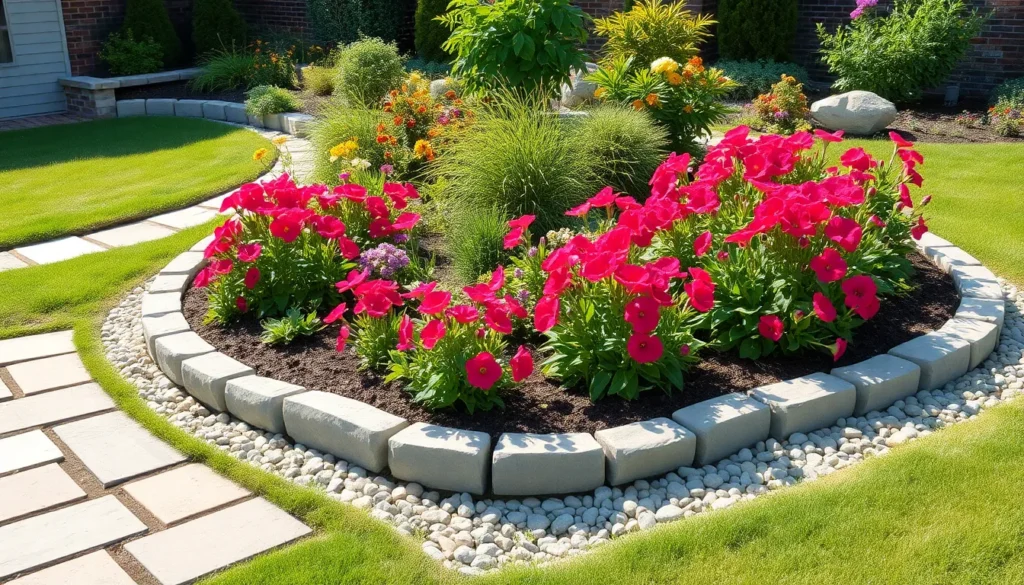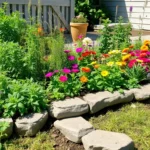Transform your garden from ordinary to extraordinary with the perfect stone edging that’ll make your neighbors stop and stare. We’ve all walked past those stunning landscapes where every flower bed looks professionally designed and wondered how they achieved that polished look.
The secret lies in choosing the right garden edging stones. Whether you’re working with a tight budget or ready to splurge on premium materials, we’ve discovered that stone edging creates clean lines while adding natural texture that complements any garden style. From rustic fieldstone to sleek modern pavers, the options are endless.
Ready to elevate your outdoor space? We’ll share our favorite stone edging ideas that deliver maximum impact with minimal effort. These proven techniques will help you create defined borders that not only look amazing but also keep mulch in place and grass out of your flower beds.
Natural Stone Garden Edging Ideas for Timeless Appeal
Natural stone edging creates an enduring foundation that complements any garden style while adding substantial value to your industry investment.
Limestone Borders for Classic Elegance
Limestone edging delivers understated sophistication that works beautifully in formal garden settings. We love how this sedimentary stone naturally weathers over time, developing a soft patina that enhances its creamy white and gray tones. Traditional English gardens showcase limestone borders alongside boxwood hedges and rose gardens, creating those coveted estate-like appearances.
Installation becomes straightforward with limestone blocks since they’re naturally flat and stack easily without mortar. Curved pathways benefit from limestone’s workability, as it cuts cleanly with standard masonry tools. Most limestone varieties cost between $3-8 per linear foot, making them accessible for larger projects.
Maintenance stays minimal because limestone naturally resists freeze-thaw cycles better than softer stones. Regular brushing removes moss buildup, while occasional power washing restores the original color. We recommend sealing limestone in areas with heavy rainfall to prevent excessive weathering.
Sandstone Edges for Rustic Charm
Sandstone edging brings warm earth tones that perfectly complement cottage gardens and informal landscapes. Colors range from golden honey to deep red, with natural variations creating visual interest along garden borders. Australian and American sandstone varieties offer different textures, from smooth river-worn surfaces to rough quarried finishes.
Versatility shines through sandstone’s natural layering, which allows for both stacked installations and single-row placements. Informal herb gardens pair beautifully with sandstone edges, especially when combined with gravel pathways. Native plant gardens benefit from sandstone’s neutral backdrop that doesn’t compete with colorful wildflowers.
Affordability makes sandstone an excellent choice for budget-conscious gardeners, typically costing $2-5 per linear foot. Regional availability often reduces transportation costs significantly. We’ve found that locally sourced sandstone creates the most cohesive look with existing industry features.
Granite Stones for Durability and Sophistication
Granite edging provides unmatched longevity and creates striking modern garden statements. This igneous rock withstands extreme weather conditions while maintaining its polished appearance for decades. Contemporary landscapes showcase granite’s clean lines alongside ornamental grasses and architectural plants like hostas and ferns.
Precision cutting allows for perfectly straight edges and tight corner joints that create professional-looking installations. Granite’s density prevents shifting and settling, making it ideal for high-traffic areas near patios and walkways. Colors include classic gray, dramatic black, and warm pink varieties that coordinate with different architectural styles.
Investment value justifies granite’s higher cost of $8-15 per linear foot because it never needs replacement. Commercial-grade installations demonstrate granite’s ability to maintain crisp edges even after years of lawn mower contact. We recommend granite for homeowners seeking permanent answers that increase property values substantially.
Creative Brick and Paver Stone Edging Designs
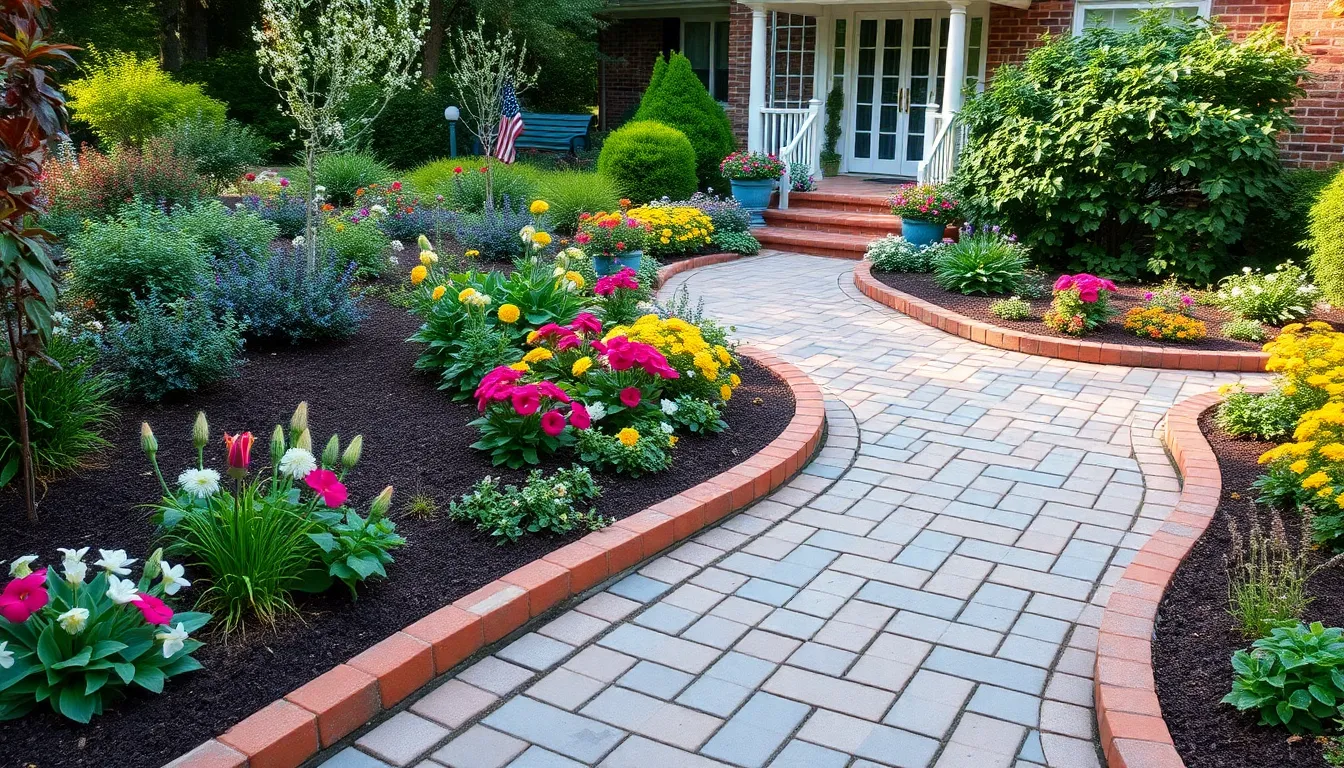
Moving beyond natural stone options, brick and paver materials offer versatile answers that combine traditional charm with modern functionality.
Traditional Red Brick Borders
Traditional Red Brick Borders create timeless elegance that complements both formal and informal garden settings. We recommend laying bricks in straight lines for clean contemporary looks, or arranging them in diagonal patterns for added visual interest. Herringbone patterns work particularly well for wider border areas, creating sophisticated geometric designs that draw the eye naturally along garden pathways.
Durability makes red brick an excellent long term investment, as these materials withstand weather changes while maintaining their classic appearance. Installation requires minimal specialized tools, making this option accessible for most DIY gardeners who want professional looking results.
Interlocking Paver Patterns
Interlocking Paver Patterns provide exceptional versatility through products like Techo-Bloc’s Villagio pavers, which deliver both durability and design flexibility. We’ve found these pavers excel at mimicking traditional cobblestone aesthetics while offering superior stability compared to loose stone options.
Multiple pattern possibilities emerge from interlocking systems, including running bond, basket weave, and circular designs that adapt to curved garden borders. Installation becomes more straightforward with interlocking edges that naturally align, reducing gaps and creating uniform appearances across entire garden perimeters.
Customization options expand through various sizes and colors available in modern paver collections, allowing us to match existing industry elements or create striking contrasts that highlight exact garden features.
Mixed Material Combinations
Mixed Material Combinations elevate garden edging through strategic layering of complementary textures and colors. Stone and gravel partnerships deliver excellent drainage while creating visually interesting transitions between different garden zones. We particularly appreciate how this combination adds natural texture variation that prevents monotonous border appearances.
Log and stone partnerships bring rustic charm through wooden elements placed vertically or horizontally alongside stone sections. These combinations work especially well in woodland gardens or cottage style landscapes where natural materials reinforce organic design themes.
Terracotta and stone combinations introduce Mediterranean warmth through clay tiles that complement neutral stone tones beautifully. Weather resistance makes terracotta tiles practical choices for year round outdoor applications, while their warm colors add inviting touches to formal stone arrangements.
River Rock and Pebble Stone Edging Solutions
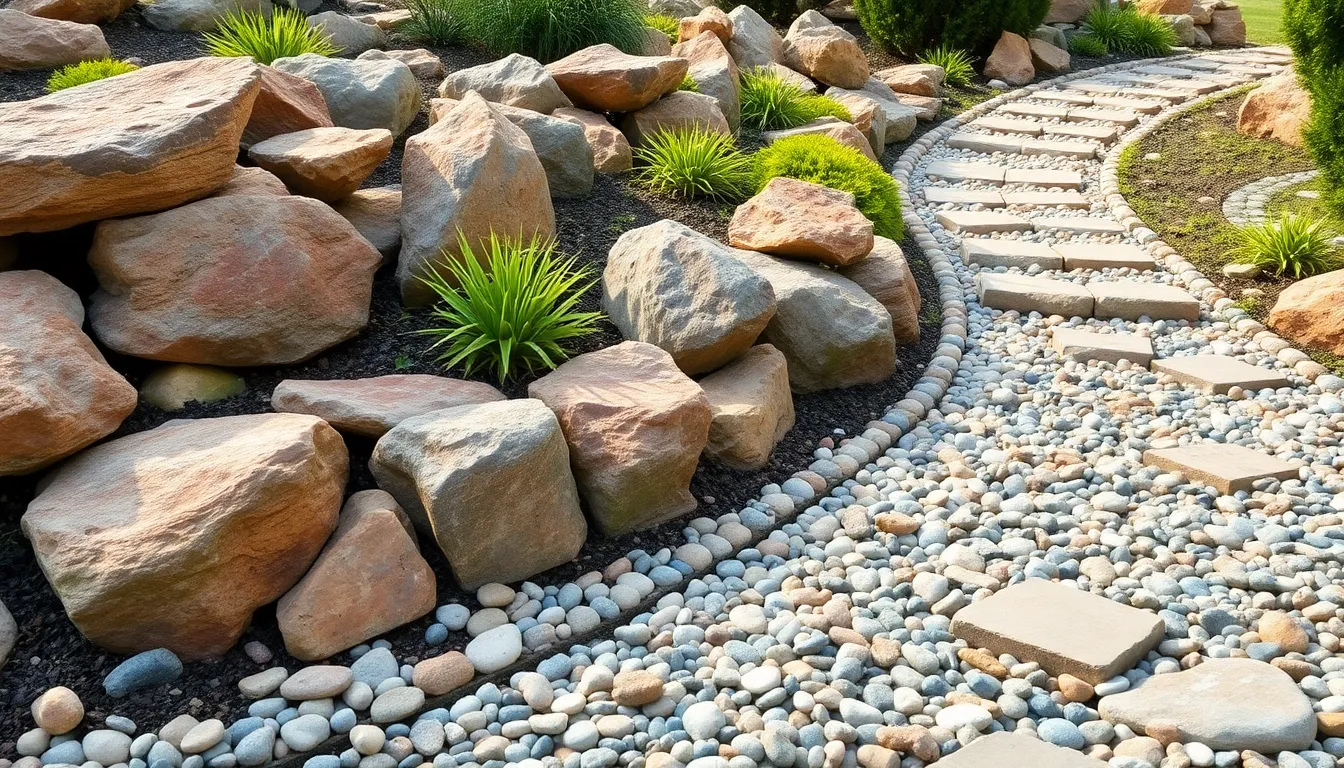
River rocks and pebbles offer versatile, low maintenance alternatives to traditional stone edging materials. We’ve found these natural elements create stunning borders that complement both formal and informal garden designs.
Smooth River Stone Arrangements
Smooth river stones deliver exceptional visual impact when arranged along curved pathways and garden borders. We recommend placing larger stones first to establish your border’s foundation, then filling gaps with smaller river rocks for a cohesive appearance. These stones work particularly well in curved designs that follow your garden’s natural industry contours.
Arranging smooth river stones in straight lines creates clean, modern borders perfect for contemporary gardens. We suggest alternating stone sizes within each row to add subtle texture variation while maintaining the overall linear aesthetic. The naturally polished surfaces reflect light beautifully throughout different seasons.
Pattern arrangements using smooth river stones can transform ordinary garden edges into artistic focal points. We’ve seen excellent results when homeowners create geometric patterns or flowing organic shapes that echo their existing industry features.
Decorative Pebble Pathways
Pebble pathways extend beyond traditional edging to create functional walkways throughout your garden space. We recommend mixing different pebble sizes to achieve optimal texture and visual depth along your garden borders. Small pebbles fill spaces between larger stones while creating intricate surface patterns.
Color coordination becomes crucial when designing decorative pebble pathways that complement your existing garden palette. We suggest selecting pebbles that either contrast boldly with surrounding plants or blend harmoniously with your home’s exterior materials.
Installing pebble pathways requires proper base preparation to ensure long term stability and drainage. We advise laying industry fabric beneath pebble installations to prevent weed growth while allowing water penetration.
Multi-Colored Stone Mixes
Multi-colored stone combinations create vibrant, ever-changing garden edging that adapts to seasonal plant changes. We’ve discovered that mixing three to four complementary stone colors produces the most visually appealing results without overwhelming your garden’s natural beauty. Earth tones like browns, grays, and tans provide excellent foundation colors for more adventurous accent stones.
Strategic color placement within mixed stone borders can guide visitors’ eyes toward exact garden focal points. We recommend clustering similar colored stones in small groups rather than distributing them randomly throughout your edging design.
Seasonal adaptability makes multi-colored stone mixes particularly valuable for year round garden appeal. We suggest choosing stone combinations that complement both spring blooms and autumn foliage to maximize your investment’s visual impact across all growing seasons.
Stacked Stone Wall Edging for Dramatic Height
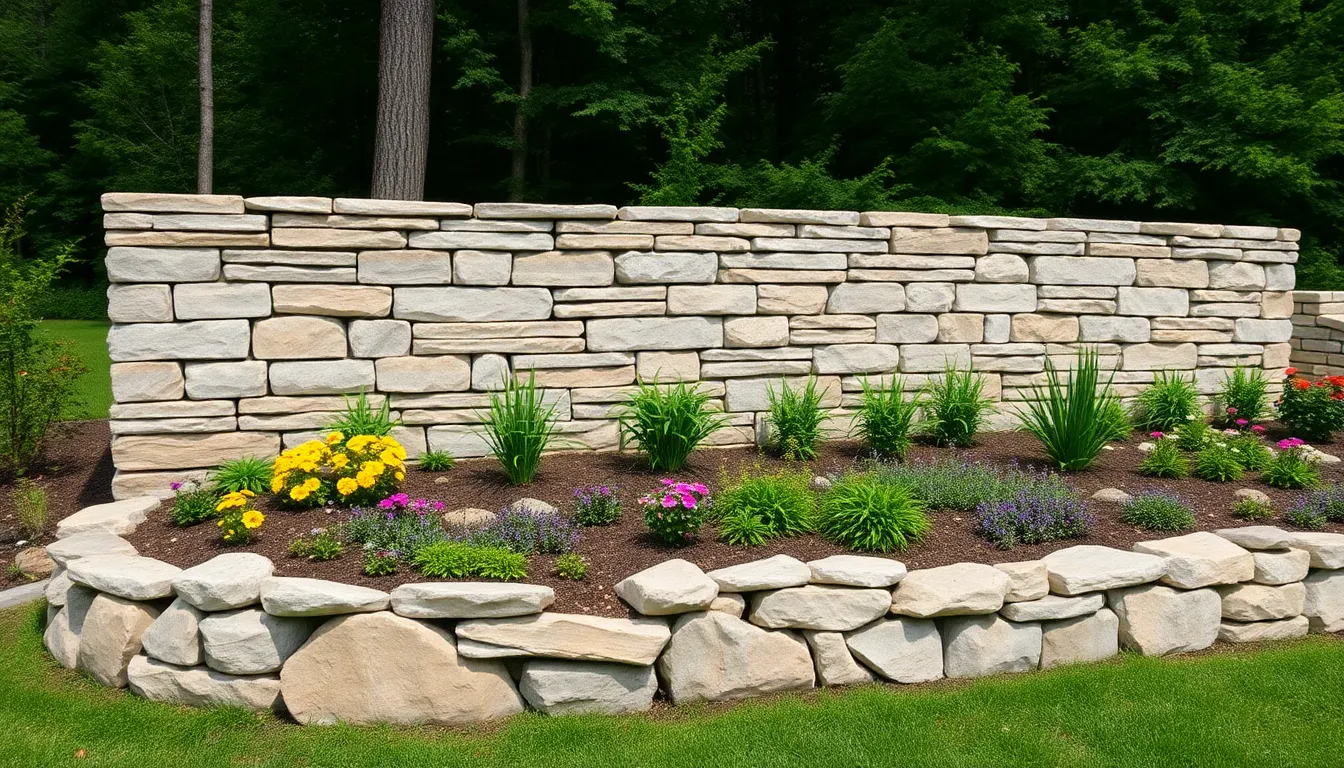
Stacked stone walls transform ordinary garden borders into striking architectural features that command attention. We’ll explore three distinct approaches that leverage vertical design to create impressive boundaries while maintaining the natural beauty that makes stone edging so appealing.
Dry Stack Fieldstone Walls
Building without mortar creates permeable barriers that manage water naturally. We recommend sourcing fieldstones locally to match your regional industry while keeping costs manageable. Gravity and careful stone selection provide all the stability these walls need.
Hand fitting each stone requires patience but delivers authentic rustic character. The interlocking shapes create a puzzle like assembly that strengthens over time. We’ve found that irregular fieldstones offer the most natural appearance for cottage style and rural garden themes.
Water permeability makes dry stack walls ideal for areas with drainage concerns. Unlike solid barriers, these structures allow moisture to pass through while reducing problematic runoff. The gaps between stones also provide microhabitats for beneficial insects and small wildlife.
Mortared Stone Retaining Edges
Mortar transforms loose stones into permanent structural elements. We use this technique when gardens require serious soil retention, particularly on slopes where erosion threatens plant health. The rigid construction withstands shifting ground and heavy rainfall.
Cut bluestone, flagstone, and cobblestone work exceptionally well with mortar applications. These materials provide clean lines that complement formal garden designs. We’ve observed that mortared edges create the most polished appearance for high traffic areas.
Sloped landscapes benefit significantly from mortared stone construction. The solid barrier prevents soil migration while creating level planting areas. This technique requires more initial investment but delivers decades of reliable performance.
Tiered Stone Garden Borders
Multiple stone levels maximize vertical space in sloped gardens. We create terraced effects that turn challenging terrain into productive planting opportunities. Each tier functions as an independent garden bed with improved drainage characteristics.
Combining dry stack and mortared techniques offers design flexibility. Lower tiers might use mortar for structural integrity while upper levels employ dry stacking for visual softness. We adapt the approach based on soil conditions and aesthetic preferences.
Mediterranean and formal garden styles showcase tiered borders beautifully. The architectural interest these structures provide elevates ordinary slopes into dramatic industry features. We’ve seen property values increase when homeowners invest in well designed tiered stone systems.
Decorative Concrete Stone Edging Options
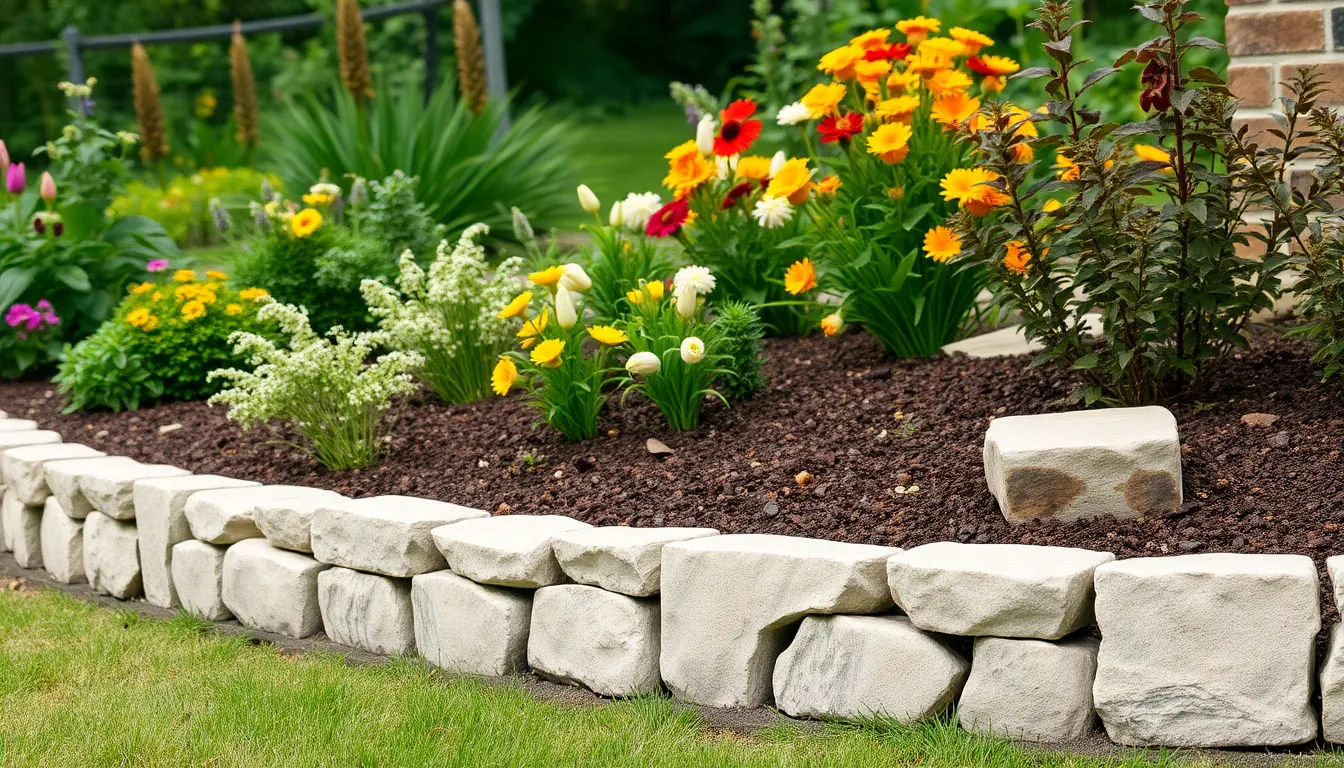
Concrete stone edging offers versatility and durability that rivals natural materials while providing greater design flexibility. Modern concrete answers deliver the authentic appearance of stone at a fraction of the cost.
Precast Concrete Border Stones
Ready-to-install border stones eliminate the complexity of mixing and pouring concrete on site. We find these prefabricated options particularly valuable for gardeners who want professional results without specialized construction skills.
Installation becomes straightforward since precast stones arrive in uniform shapes and sizes that fit together seamlessly. Your garden edges maintain consistent alignment and spacing throughout the entire border.
Cost considerations favor precast options when compared to custom poured concrete, though prices vary significantly based on supplier and design complexity. We recommend comparing local suppliers to find the best value for your exact project needs.
Design consistency remains one of the strongest advantages of precast concrete borders. Each stone matches perfectly with others in the series, creating clean lines that complement both formal and informal garden styles.
Stamped Concrete Edge Designs
Pattern stamping transforms plain concrete into realistic stone textures that fool even close inspection. We’ve seen installations where visitors couldn’t distinguish stamped concrete from actual fieldstone or slate.
Professional installation becomes essential for achieving the desired texture and pattern quality. Skilled contractors know how to time the stamping process perfectly with concrete curing for optimal results.
Coloring options enhance the realistic appearance by matching natural stone variations found in your region. Custom color blends can coordinate with existing hardscape elements like patios or walkways.
Visual appeal increases dramatically when stamped patterns mimic natural stone textures such as cobblestone, slate, or irregular fieldstone. Your garden edges gain sophisticated character that complements various industry themes.
Colored Concrete Stone Alternatives
Staining techniques create authentic granite or slate appearances without the environmental impact of quarrying natural stone. We recommend integral color additives for longer-lasting results compared to surface staining.
Color matching capabilities allow concrete edges to blend seamlessly with existing stone features in your industry. Professional color consultation ensures your new edging complements rather than clashes with established design elements.
Environmental benefits make colored concrete an eco-conscious choice since it eliminates stone transportation and quarrying impacts. Your garden project reduces carbon footprint while achieving the desired aesthetic appeal.
Enhancement through painting provides additional customization options for exact color requirements that standard concrete stains cannot achieve. Multiple coating systems protect the surface while delivering vibrant, long-lasting color that withstands weather exposure.
Flagstone Edging Ideas for Irregular Beauty
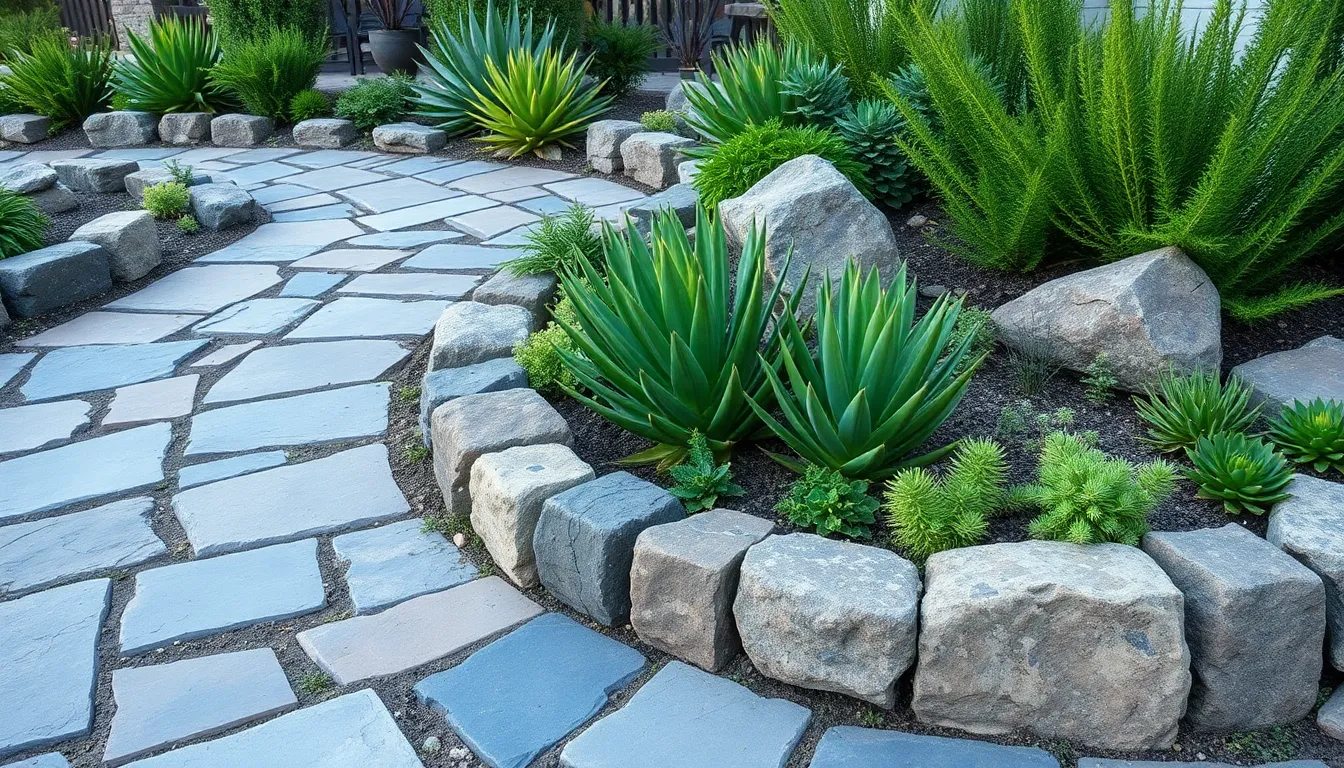
Flagstone edging brings natural, organic charm to garden borders through its irregular shapes and varied textures. These versatile stones create stunning visual boundaries that complement both formal and informal industry designs.
Pennsylvania Bluestone Borders
Pennsylvania Bluestone transforms garden edges with its distinctive blue-gray coloration that adds sophisticated elegance to any industry design. We recommend installing these durable stones in overlapping patterns to create flowing, natural boundaries that enhance both contemporary and traditional garden styles.
Arranging Pennsylvania Bluestone requires minimal cutting since its natural irregular shapes fit together like puzzle pieces along curved pathways. Installing these borders works best when you excavate 2-3 inches deep and use sand as a leveling base beneath each stone. Creating visual interest becomes effortless as the stone’s natural color variations shift from deep blue to warm gray tones throughout the day.
Maintaining Pennsylvania Bluestone borders requires only occasional cleaning with water and a stiff brush to preserve their natural beauty. Improving the stone’s appearance happens naturally over time as weathering creates subtle texture changes that blend seamlessly with surrounding plants.
Arizona Flagstone Arrangements
Arizona Flagstone creates warm, earthy garden borders that perfectly complement desert landscapes and Mediterranean-style gardens. We’ve found these stones work exceptionally well in xeriscaping projects where their natural rust and tan colors echo the surrounding desert environment.
Designing with Arizona Flagstone allows for creative freedom since each piece features unique patterns and color variations ranging from deep red to golden brown. Positioning these stones works best when you alternate larger anchor pieces with smaller connecting stones to create natural flow along garden beds. Establishing proper drainage becomes crucial in Arizona Flagstone installations since the stone’s porous nature benefits from good water management.
Combining Arizona Flagstone with drought-tolerant plants like succulents and native grasses creates stunning contrast between the warm stone tones and green foliage. Weathering enhances these stones over time as natural elements bring out deeper color saturation and interesting surface textures.
Mixed Flagstone Patterns
Mixed flagstone patterns offer unlimited creative possibilities by combining different stone types to achieve unique, textured garden borders. We recommend blending Pennsylvania Bluestone with Arizona Flagstone to create ever-changing color contrasts that adapt to changing light conditions throughout the day.
Alternating different flagstone varieties in repeating patterns creates rhythm and visual movement along lengthy garden borders. Balancing cool blue-gray stones with warm earth-toned pieces requires strategic placement where lighter stones highlight focal points and darker stones provide grounding elements. Transitioning between different stone types works smoothly when you gradually shift from one variety to another rather than creating abrupt changes.
Layering mixed flagstone patterns adds depth and dimension to garden edges while maintaining the natural, irregular beauty that makes flagstone so appealing. Coordinating your stone selection with existing hardscape elements like patios or walkways ensures visual harmony throughout your entire industry design.
Modern Steel and Stone Combination Edging
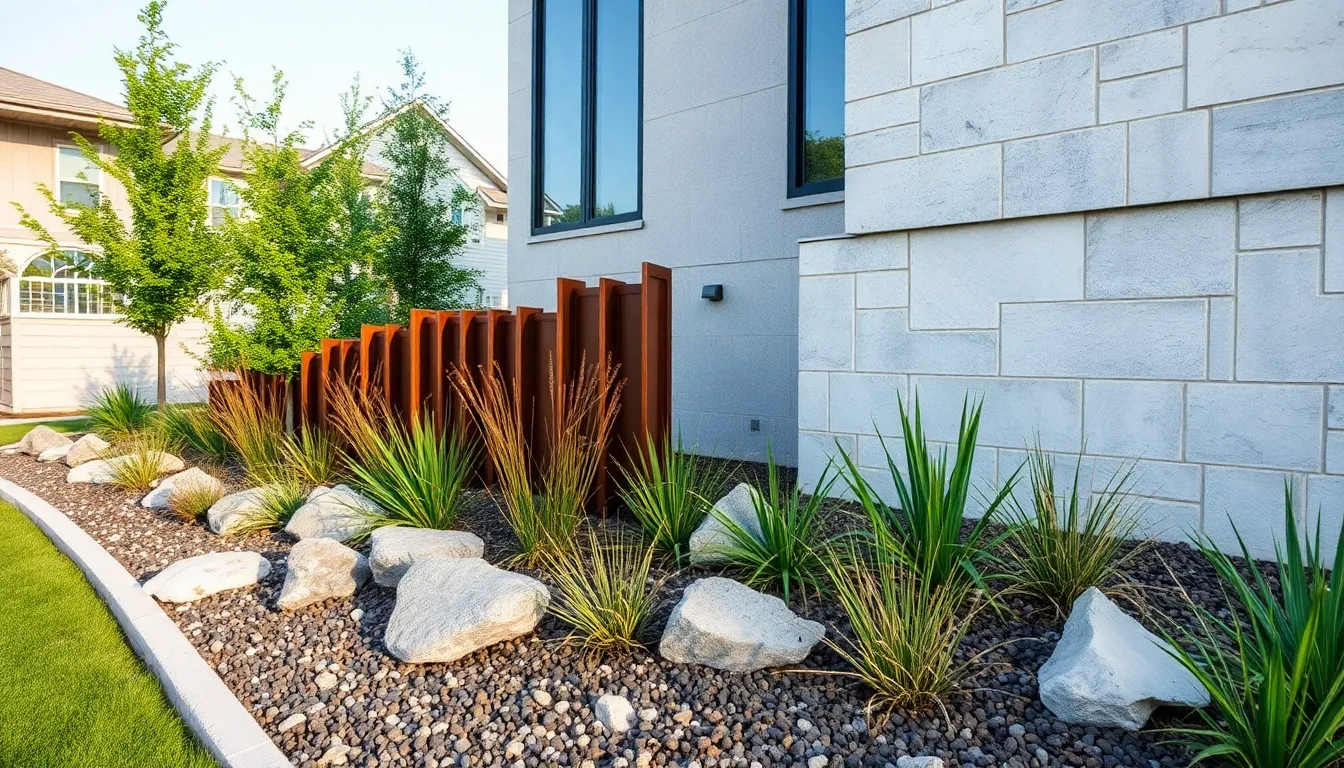
Contemporary garden design embraces the striking fusion of industrial metals with natural stone elements. These sophisticated combinations create dramatic focal points that elevate traditional landscaping into modern art installations.
Corten Steel with Stone Accents
Weathering steel transforms your garden borders into sculptural masterpieces that evolve over time. The natural oxidation process creates a protective patina that shifts from bright orange to deep chocolate brown, forming a stunning backdrop for carefully selected stone accents.
We recommend pairing Corten steel panels with limestone or travertine stones to create visual contrast. Position larger stone specimens at regular intervals along the steel edging to break up the linear design. This combination works exceptionally well in contemporary homes where the industrial aesthetic complements clean architectural lines.
Installing Corten steel requires proper drainage considerations since water accelerates the weathering process. Place decorative river rocks or crushed granite at the base to manage runoff while adding textural interest. The steel’s warm rust tones harmonize beautifully with earth tone stones like sandstone or slate.
Galvanized Steel Frame Stone Borders
Galvanized steel frames provide structural integrity while showcasing natural stone collections within defined boundaries. These durable metal enclosures protect loose stone materials from displacement while maintaining crisp, professional edges.
We suggest using galvanized steel strips bent into custom shapes to contain decorative pebbles or crushed stone. The zinc coating prevents rust formation, ensuring longevity in wet climates. Fill the framed sections with contrasting stone colors like white marble chips against dark steel for maximum visual impact.
Creating raised borders becomes effortless with galvanized frameworks that support stacked stone walls. The metal structure eliminates the need for mortar while allowing natural drainage between stones. This technique works particularly well for Mediterranean style gardens where formal geometry meets organic textures.
Contemporary Metal-Stone Hybrids
Mixed material edging answers combine multiple metals and stones to create ever-changing, layered designs. These hybrid approaches allow creative expression while maintaining practical functionality for various garden conditions.
We recommend alternating sections of brushed aluminum panels with natural fieldstone clusters for a sophisticated urban look. The metal reflects light during different times of day while the stone provides grounding weight to the overall design. This combination adapts beautifully to both formal and informal industry styles.
Powder coated steel inserts can frame individual stone specimens, creating gallery like displays within your garden borders. Choose stones with interesting shapes or colors to serve as focal points within the metal frames. The contrast between smooth metal surfaces and rough stone textures adds depth and visual intrigue to walkways and planting beds.
Budget-Friendly DIY Stone Edging Projects
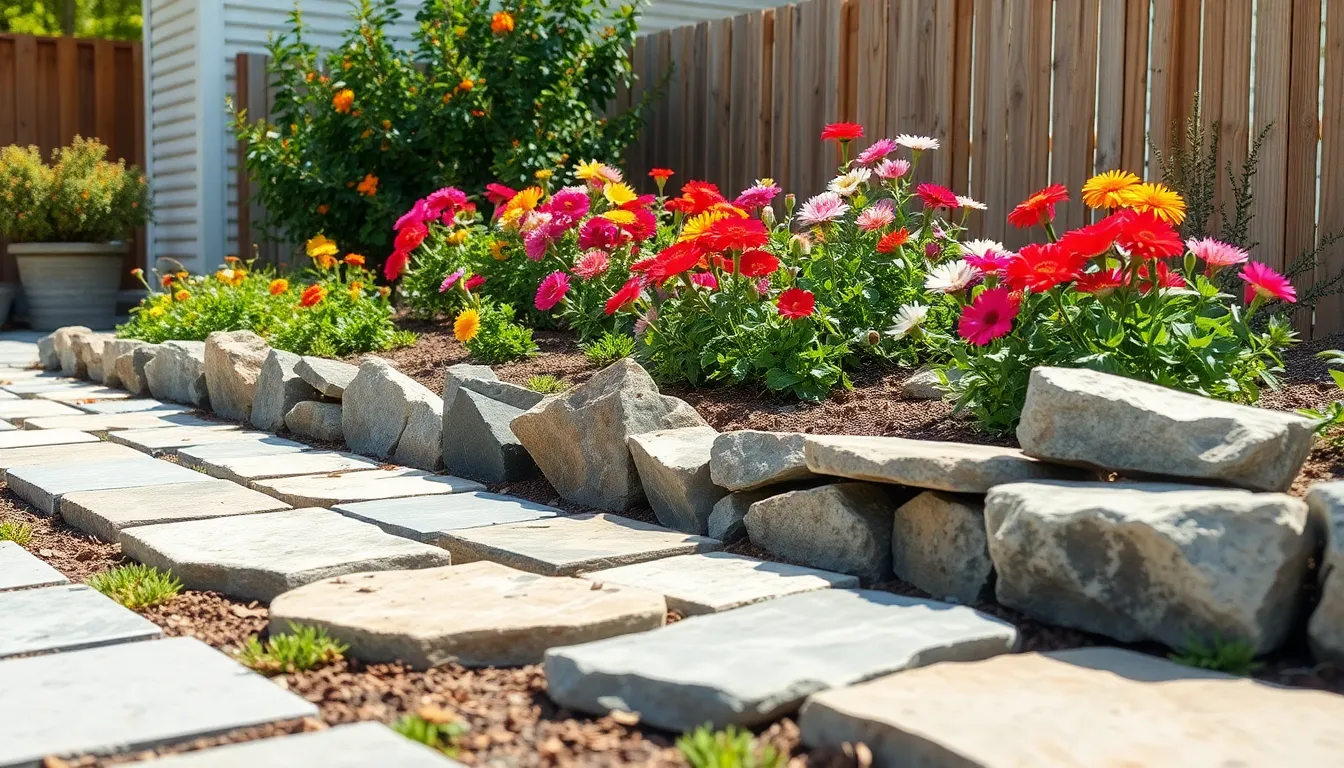
Budget-friendly stone edging projects can transform your garden without stretching your finances. We’ve compiled practical approaches that maximize visual impact while keeping costs low.
Salvaged Stone Border Ideas
Reclaimed stone walls offer exceptional value when sourced from demolished structures or renovation sites. We recommend exploring construction debris piles where contractors often discard perfectly usable stones that can create rustic borders with authentic weathered character.
Repurposed stone slabs from old patios or walkways make excellent garden edging materials. Cut these salvaged pieces to fit around your garden beds for an eclectic look that tells a story while reducing waste and expenses.
Architectural salvage yards frequently stock unique stone pieces from historic buildings and structures. Browse these locations for distinctive elements like limestone blocks, sandstone fragments, or granite curbing that add personality to your garden borders.
Local Stone Sourcing Tips
Visit local quarries to access fresh stone materials at wholesale prices rather than retail markups. Many quarries sell directly to homeowners and offer volume discounts for larger projects.
Check online marketplaces like Craigslist and Facebook Marketplace where homeowners sell surplus materials from completed projects. Search for terms like “landscaping stone,” “garden rock,” or “edging materials” to find deals in your area.
Community gardens often maintain resource lists and connections with local stone suppliers. Connect with these organizations to access group purchasing opportunities or recommendations for affordable stone sources.
Construction sites sometimes allow material pickup when contractors have excess stone deliveries. Contact site supervisors to inquire about purchasing surplus materials at discounted rates.
Simple Installation Techniques
Lay a proper base using compacted gravel or coarse sand to create stable support for your stone edging. This foundational layer prevents settling and maintains alignment over time.
Level the installation area with a rake and string line before placing stones to ensure consistent height and professional appearance. Remove grass and weeds from the edging path to prevent future growth issues.
Stack stones strategically for raised bed applications by placing larger stones at the bottom and smaller pieces on top. This technique creates stability while using materials efficiently.
Secure stones with sand by filling gaps between pieces with fine sand or stone dust. Sweep additional sand over the installation and water lightly to lock stones in place while maintaining proper drainage.
Low-Maintenance Stone Edging Designs
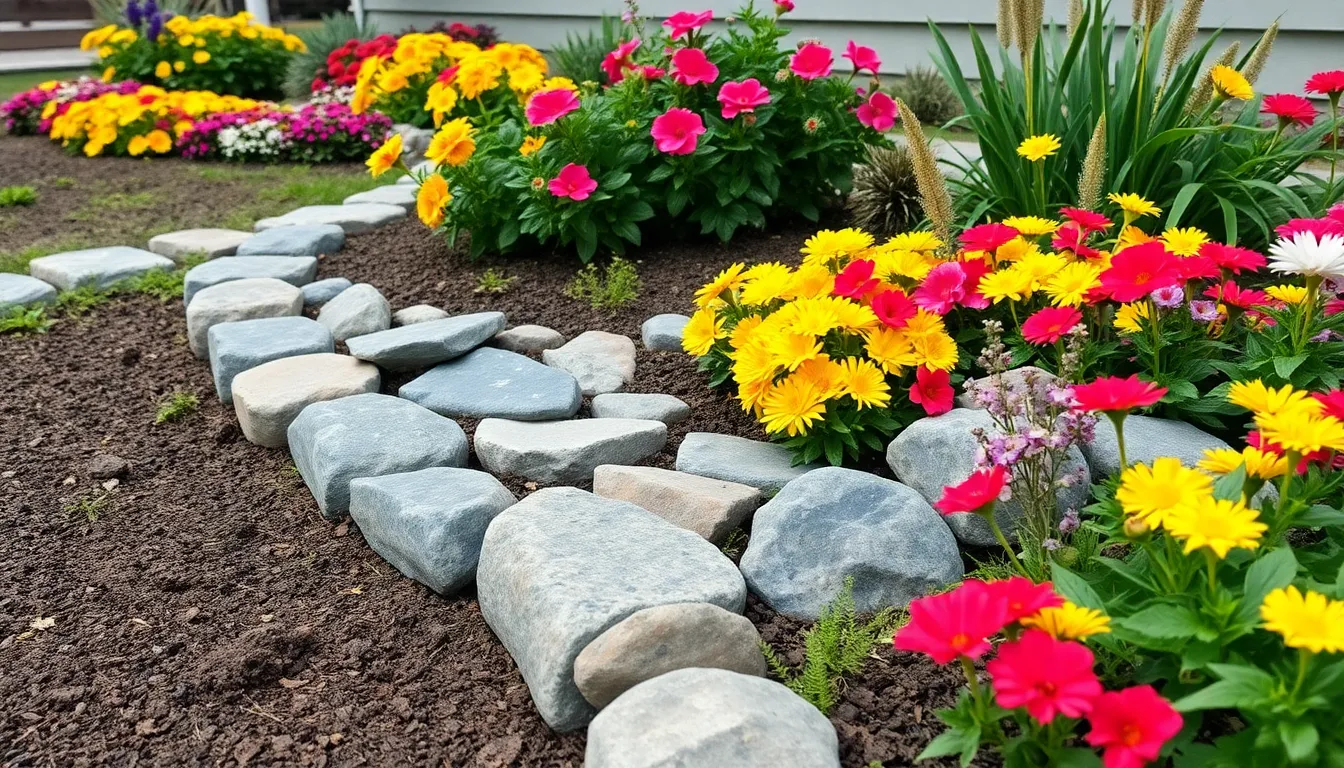
Low-maintenance stone edging answers transform your garden borders without demanding constant attention or frequent repairs. We’ll explore strategic approaches that minimize weeding, manage drainage naturally, and reduce ongoing maintenance requirements.
Weed-Resistant Stone Arrangements
Layered stone installations with landscaping fabric underneath create an effective barrier against unwanted vegetation. We recommend placing a quality weed barrier beneath your stone edging to prevent weeds from pushing through gaps and establishing roots in your border areas.
Tight-fit stone configurations eliminate the spaces where weeds typically take hold and flourish. Close-fitting stones like granite, limestone, and sandstone create seamless borders that block weed growth while maintaining clean, professional lines throughout your garden.
River rock arrangements provide natural weed suppression through their smooth, interlocking surfaces. These naturally polished stones settle together tightly, creating fewer opportunities for weed seeds to find purchase and germinate between individual pieces.
Self-Draining Border Answers
Gravel base systems beneath stone edging prevent water accumulation and protect against erosion damage. Proper drainage foundation using crushed gravel allows water to flow freely away from your stone borders, maintaining structural integrity during heavy rainfall periods.
Sloped edging installations direct water away from planted beds and prevent waterlogging around sensitive plant roots. We suggest angling your stone borders slightly away from garden beds to encourage natural water runoff and maintain optimal soil moisture levels.
Permeable stone selections like flagstone and slate allow water to flow through naturally occurring gaps. These materials work with your industry’s natural drainage patterns rather than blocking water movement and creating standing water problems.
Minimal Upkeep Stone Options
Flagstone edging delivers exceptional durability with virtually no maintenance requirements for both modern and traditional garden styles. This versatile natural stone maintains its appearance year after year without needing replacement, cleaning, or structural adjustments.
Slate edging provides a sleek, contemporary appearance that requires minimal intervention once properly installed. The dense composition of slate resists weathering, chipping, and color fading, making it an ideal choice for busy homeowners seeking long-term answers.
Natural stone varieties including granite, limestone, and sandstone offer the ultimate low-maintenance approach while potentially improving your property value. These time-tested materials withstand decades of weather exposure without losing their structural integrity or visual appeal.
Conclusion
We’ve explored countless ways to transform your garden borders with stone edging that fits every style and budget. From natural limestone’s timeless elegance to modern steel combinations these answers offer both beauty and practical benefits.
The key to success lies in choosing materials that complement your industry while considering maintenance requirements and installation complexity. Whether you’re drawn to DIY salvaged stone projects or professional flagstone installations there’s an option that’ll work for your space.
Remember that proper preparation creates lasting results. A solid foundation and thoughtful stone selection will give you borders that enhance your garden’s appeal for years to come while keeping maintenance to a minimum.
Frequently Asked Questions
What are the best types of stone for garden edging?
The most popular stone edging materials include limestone for classic elegance, sandstone for rustic charm, and granite for modern durability. Natural river rocks and flagstone also offer excellent options, with each material providing different aesthetic appeals and maintenance requirements. Choose based on your garden style, budget, and desired longevity.
How much does stone edging cost compared to other materials?
Stone edging costs vary widely depending on the material chosen. Natural stones like granite are premium options, while sandstone and concrete alternatives offer budget-friendly solutions. Salvaged stones and local quarry materials can significantly reduce costs. DIY installation further saves money compared to professional installation.
Can I install stone edging myself or do I need a professional?
Most stone edging projects are DIY-friendly with proper preparation. Simple installations like river rock borders and flagstone edging require basic tools and techniques. However, complex projects like mortared retaining walls or large stacked stone installations may benefit from professional expertise for structural integrity.
How do I maintain stone garden edging?
Stone edging is generally low-maintenance. Regular tasks include removing weeds, occasionally repositioning loose stones, and ensuring proper drainage. Natural stones like flagstone and slate require minimal upkeep. Installing landscaping fabric underneath and using tight-fit configurations can significantly reduce maintenance needs.
What’s the difference between natural stone and concrete stone edging?
Natural stone offers authentic textures and colors but costs more and may require more installation time. Concrete stone alternatives provide consistent shapes, cost-effectiveness, and design flexibility through stamping and coloring techniques. Both options offer durability, but natural stone typically adds more property value.
How do I choose the right stone edging for my garden style?
Consider your garden’s overall aesthetic: limestone suits formal gardens, sandstone works well in informal landscapes, and granite complements modern designs. River rocks are versatile for curved borders, while flagstone adapts to various styles. Factor in your budget, maintenance preferences, and existing landscape elements.
Can stone edging help with garden maintenance?
Yes, stone edging serves practical purposes beyond aesthetics. It keeps mulch contained, prevents grass encroachment into flower beds, provides clear mowing lines, and can improve drainage. Proper installation with landscaping fabric creates effective weed barriers, reducing ongoing garden maintenance requirements.
What preparation is needed before installing stone edging?
Proper preparation includes marking the border layout, excavating to appropriate depth, creating a level base with compacted gravel or sand, and installing landscaping fabric if desired. For curved designs, use a garden hose to outline the shape. Adequate base preparation ensures stability and prevents shifting over time.

